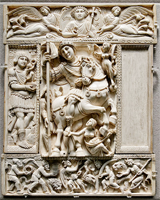
This page created 10 April 2014, and last modified: 30 November 2014 (Maier reference numbers added)

In the eastern half of the empire, the 8th of the 17 units of unit of auxilia palatina listed (12.30 in Ingo Maier's numbering scheme) under the command of the second Master of the Soldiers in the Imperial Presence (i.e. the Magister Militum Praesentalis II) is called the Sagittarii dominici. The corresponding shield pattern (11#6) as shown in various manuscripts, under the matching label (11.f) Sagittarii dominici, is as below:

The shield pattern features a yellow boss encircled by a red band; the main ground is purple (faded to maroon in M & W, and more indigo in P); no rim is apparent. Flanking the boss are two winged victories in black (clothed green in B with white skin); at the 12 o'clock position is a large portrait-style head. This shield pattern is similar to that of the previous unit assigned to the same command, that of the Sagittarii iuniores Orientales, and it is also very similar to other Sagittarii units, under the other Master of the Soldiers in the Imperial Presence, as the following patterns taken from the Paris manuscript should help to illustrate:

These shield patterns, showing a pair of Victories flanking what appears to be an image of an imperial couple (or, in the case of the Sagittarii dominici, a single personage), are all very similar, and clearly form a set of related units. That of the Sagittarii dominici would appear to be the least similar to the other four, and this is matched by its name being similarly not quite as well-matched. Interestingly, two other eastern units show similar paired Victories: the Domestici equites and the Domestici pedites, under the commands of the Count of the Household Horse and Count of the Household Foot, respectively.
Paired Victories flanking an imperial image are a characteristic late Roman motif, and can also be found on e.g. the Arch of Constantine (although in this case the imperial image has been lost; single Victories are also used on the same monument). The motif continued into the Byzantine era; the picture below of the early-6th century Barberini ivory in the Louvre shows how the Victories have been transformed into angels, and have been elevated to flanking a heavenly Christ rather than the earthly emperor.

Photo by Marie-Lan Nguyen and released into the public domain.
The name Sagittarii dominici implies (but does not establish) the unit was bow-armed. It is apparent that "dominici" does not relate to "Lord" as might be first assumed, but rather Albia Dominica - the wife of the emperor Valens, and thus the portrait of the shield pattern is of her. The Sagittarii Dominici (better spelled with a capital "D") is found in 8th place amongst the auxilia palatina under the command of the second Master of the Soldiers in the Imperial Presence; in 8th place amongst the auxilia palatina under the command of the first Master of the Soldiers in the Imperial Presence is found the Tertii sagittarii Valentis, which is clearly named after Dominica's husband, the emperor Valens. Given he reigned for a considerable time (364-378) not long before the Notitia was compiled, it is rather striking how few units in the Notitia are clearly named after him, especially when compared to the number of units named after his brother and co-Augustus, Valentinian. See Noel Lenski, Failiure of Empire: Valens and the Roman state in the fourth century A.D. (2002), page 317, note 322; Lenski uses this as an indication of the difficuly Valens had in recruiting soldiers. But Lenski makes no mention how the title Tertii sagittarii Valentis might well imply the existence at least two other units of sagittarii Valentis, perhaps lost at Adrianople, which might make Valens' recruiting efforts seem more accomplished than is immediately evident.
Given the correlation in the list positions of these two units, their names, and their shield patterns, it is clear these two units are a matched pair.

Return to the Notitia alphabetical unit list page.
Return to my Notitia index page.